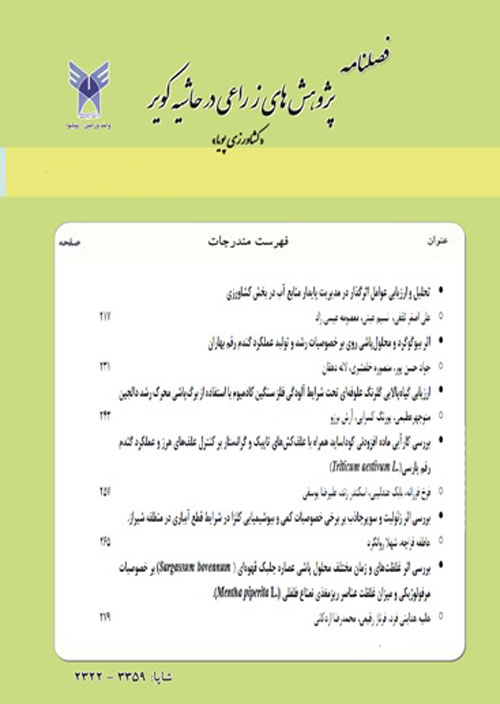Effect of water deficit stress on winter grain yield, oil, and yield components of 20 canola cultivars
Author(s):
Abstract:
In order to analyze the effect of low-water stress on yield, yield components, and qualitative characteristics of Canola varieties, a study was conducted in a split plots design in randomized complete blocks design with four replications, at a research farm of Grain Breeding and Supplement Institute of Karaj, in 2005-2006. In this study the main factor was irrigation which was used in two different levels; first, a normal irrigation based on 80 ml evaporation from the evaporation basin of class A, and second, low- water stress which was irrigation cut from stemming level. The secondary factor was 20 varieties of Canola. The results obtained indicated that there was a significant difference in grain yield between irrigation levels and varieties at 0.05 level of significance and also in interactive effects of irrigation – variety at 0.01 level of significance. Comparison of the means in irrigation levels showed that the grain yield in normal irrigation condition was 4191.1kg/ha, whereas in stress condition it was 3755.4kg/ha. Comparison of the means of varieties revealed that Var. Syn-4 (4411.8 kg/ha) had the maximum grain yield. This variety had the maximum biologic yield as well. Var. Alice (2885.4 kg/ha) had the minimum grain and biologic yield at the same time. By comparing the means of interactive effects of irrigation – variety for grain yield, it was indicated that Licord (4961 kg/ha) in normal irrigation and Opera (2825 kg/ha) in stress condition had the maximum and minimum grain yield, respectively. Besides, the oil yield results revealed that there was a significant difference between irrigation levels and varieties at 0.05 level of significance and also in interactive effects of irrigation- variety at 0.01 level of significance. Comparing the means of interactive effects of irrigation- variety showed that Licord (2278 kg/ha) in normal irrigation and Opera (1271 kg/ha) in stress condition had the maximum and minimum oil yield, respectively. Besides, the results indicated that grain weight, the number of sheaths in secondary branches and the main stem and also the number of grains in sheaths, Hn regards to cultivars, was significant difference at 0.01 level. Between the grain weight and the number of sheaths in secondary branches and the main stem, at irrigation level, was a significant difference at 0.01 levels. Whereas, there was no significant difference among yield components in interactive irrigation and cultivars.
Language:
Persian
Published:
Iranian Journal of Dynamic Agriculture, Volume:3 Issue: 3, 2006
Page:
1
magiran.com/p502966
دانلود و مطالعه متن این مقاله با یکی از روشهای زیر امکان پذیر است:
اشتراک شخصی
با عضویت و پرداخت آنلاین حق اشتراک یکساله به مبلغ 1,390,000ريال میتوانید 70 عنوان مطلب دانلود کنید!
اشتراک سازمانی
به کتابخانه دانشگاه یا محل کار خود پیشنهاد کنید تا اشتراک سازمانی این پایگاه را برای دسترسی نامحدود همه کاربران به متن مطالب تهیه نمایند!
توجه!
- حق عضویت دریافتی صرف حمایت از نشریات عضو و نگهداری، تکمیل و توسعه مگیران میشود.
- پرداخت حق اشتراک و دانلود مقالات اجازه بازنشر آن در سایر رسانههای چاپی و دیجیتال را به کاربر نمیدهد.
In order to view content subscription is required
Personal subscription
Subscribe magiran.com for 70 € euros via PayPal and download 70 articles during a year.
Organization subscription
Please contact us to subscribe your university or library for unlimited access!


